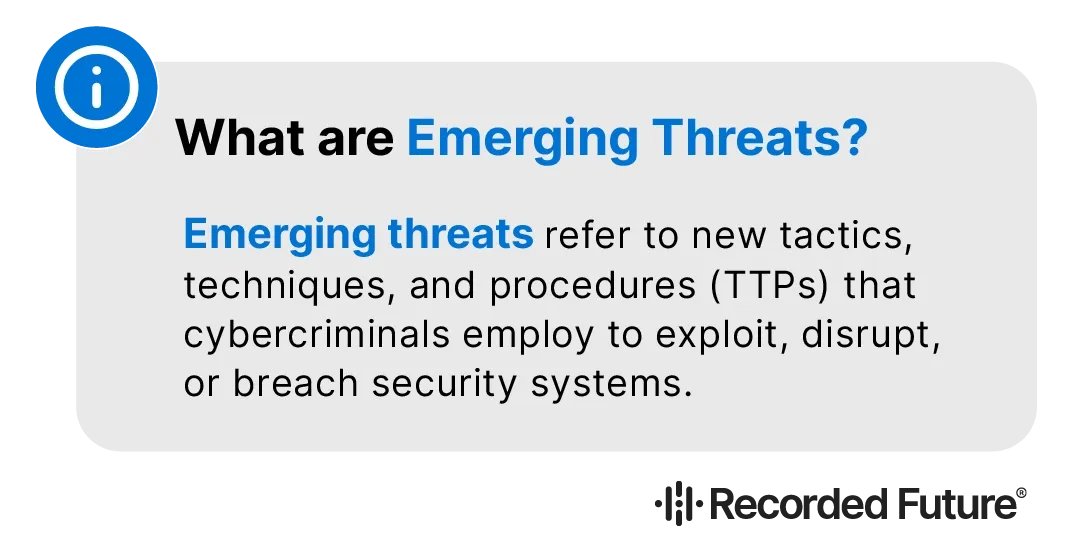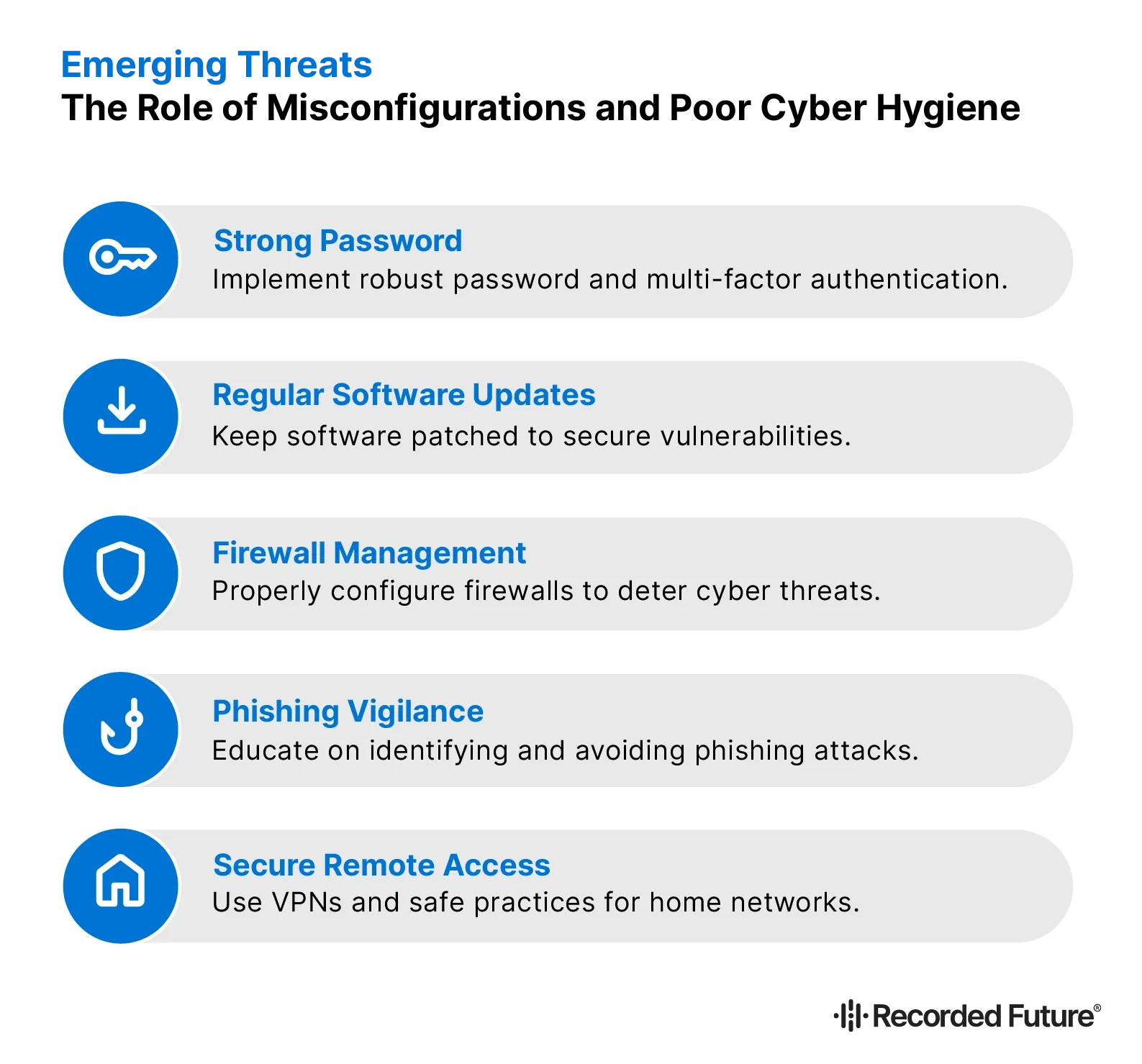What are Emerging Threats?

With cyber threats becoming more complex and varied, the question arises: are we equipped to defend against these hidden predators in our data networks? Our ability to navigate these challenges depends on understanding the threats and being agile in our responses. Let’s explore the newest cyber threats and how to effectively protect our digital future.
Key Takeaways
- Understand and identify emerging cyber threats through threat intelligence, hybrid threats, and cybersecurity education.
- Implement multi-factor authentication to reduce vulnerability to social engineering attacks. Address third party exposure with transparency measures & strong security protocols.
- Leverage AI in cybersecurity tools for faster threat detection. Collaborate between government & private sector for stronger defense against cyber threats.
Understanding Emerging Cyber Threats
In the complex world of cybersecurity, comprehension is a crucial part of the struggle. Emerging cyber threats are not just roadblocks; they are evolving adversaries that change tactics and strategies, keeping us on our toes.
The key to staying ahead lies in threat intelligence, a proactive approach to security that focuses on understanding the motivations, capabilities, and indicators of compromise of threat actors. Navigating through the complex labyrinth of cybersecurity, we stumble upon diverse threats, each presenting its own unique hurdles.
The use of artificial intelligence in phishing attacks is a prime example, where hackers use machine learning to craft convincing fraudulent messages, leading to a significant upsurge in data breaches. As we dig deeper, we encounter hybrid threats, a sinister blend of tactics aimed at infiltrating networks and gathering data, making them hard to address individually due to their multifaceted characteristics.
Within this battleground of codes and firewalls, a critical factor - human error, is often neglected. It underscores the need for effective cybersecurity education to mitigate these evolving threats.
What are Emerging Threats in Cybersecurity?

In the realm of cybersecurity, emerging threats refer to new tactics, techniques, and procedures (TTPs) that cybercriminals employ to exploit, disrupt, or breach security systems. These threats constantly evolve, making them harder to predict and mitigate. They range from sophisticated malware and ransomware attacks to social engineering tactics and advanced persistent threats (APTs). As technology advances, so too do these threats, leveraging the latest developments in artificial intelligence, machine learning, and IoT devices to carry out their malicious activities.
Identifying Emerging Threats
To gain an upper hand over an adversary, we first need to understand them. Identifying new cybersecurity threats is akin to staying one step ahead in a chess game. It involves being privy to the latest trends, tactics, and vulnerabilities in the threat landscape. The recent surge of malicious mobile applications is a case in point, where seemingly harmless downloads have turned into Trojan horses, infiltrating corporate networks and compromising sensitive data.
As we augment our understanding of these threats, we also need to equip ourselves with advanced strategies and technologies, such as AI-driven threat detection and a heightened emphasis on supply chain security.
The Role of Human Error
The most vulnerable aspect in any security chain is the human factor. A simple oversight, a misplaced click, or a forgotten update - human error significantly influences cybersecurity breaches. Studies from Stanford University, Tessian, and IBM suggest that between 88% to 95% of cyber breaches, including data breaches, can be attributed to human error.
This highlights the importance of:
- Fostering a secure culture within an organization
- Ensuring accessibility of security policies
- Providing comprehensive education to employees on the significance of strong passwords and avoiding common security errors.
Evolving Social Engineering Tactics
Social engineering attacks are the trojan horses of the cybersecurity world. They prey on the human element, exploiting trust and familiarity to gain unauthorized access. From the rise in business email compromise (BEC) attacks to the exploitation of human vulnerability, social engineering tactics have evolved in sophistication and impact. They are no longer simple phishing attacks but have grown into a whole gamut of deception-based threats that manipulate human psychology.
To counter these evolving tactics, we need strong fortifications - and multi-factor authentication serves as one such bulwark. By requiring users to provide multiple credentials for identity verification, it bolsters security measures and reduces susceptibility to social engineering attacks. However, it’s not just technology that forms our defensive line. Education and awareness play a vital role in equipping individuals to identify suspicious emails or unsolicited requests, fostering a culture of security within organizations.
Multi-Factor Authentication
In cybersecurity, multi-factor authentication serves as the guardian shielding your data from potential breaches. It operates on a simple premise - multiple locks are harder to pick than one. Multi-factor authentication mandates users to furnish a combination of knowledge-based factors (like passwords), possession-based factors (such as security tokens), and inherence-based factors (biometric verification), thereby enhancing security measures against unauthorized access.
Even if an attacker manages to acquire a user’s credentials, they would still require an additional factor to gain access, making unauthorized access significantly more challenging.
Addressing Third-Party Exposure
In the intricately linked digital realm, third-party exposure poses as an open backdoor for hackers, often leading to a data breach. It refers to potential vulnerabilities arising from less-secure networks of third parties who have authorized access to the main target. A significant instance of a third-party breach occurred in 2021 when hackers exposed personal information from more than 214 million Facebook, Instagram, and LinkedIn accounts through a third-party contractor named Socialarks.
Tackling these threats necessitates a comprehensive strategy. Here are some key steps to consider:
- Implement transparency measures to monitor emerging risks during onboarding and throughout the duration of a vendor contract.
- Implement digital risk protection to mitigate the heightened threats associated with remote work by enforcing robust security measures and protocols.
- Enhance supply chain risk monitoring to gain greater visibility into risks and threats to third party vendors, software, and physical locations.
- Limit external parties’ access to crucial systems and data to minimize the potential attack surface for cybercriminals.
By following these steps, organizations can better protect themselves against cybersecurity threats.
Supply Chain Vulnerabilities
In the context of third-party exposure, supply chain vulnerabilities pose a considerable risk. When malicious actors exploit vulnerabilities in the software supply chain, they gain unauthorized access to an organization’s network. Addressing these vulnerabilities requires transparency, regular audits, and strong security measures.
By identifying and mitigating risks, building trust, managing expectations, and enhancing resilience, organizations can effectively navigate the treacherous waters of supply chain vulnerabilities.
Tackling Configuration Mistakes and Poor Cyber Hygiene

Configuration errors and inadequate cyber hygiene can create gaping vulnerabilities for cyber-attacks within an organization. A misplaced character in code or a forgotten update could be all it takes for an attacker to infiltrate an organization’s defenses. With remote work becoming the norm following the COVID-19 pandemic, these risks are further exacerbated.
Some common vulnerabilities, which can be considered as top cybersecurity threats, include:
- Weak passwords
- Lack of multi-factor authentication
- Unpatched software
- Misconfigured firewalls
- Phishing attacks
Accessing systems through insecure home networks or personal devices can elevate the risk of exposure to breaches.
To mitigate these risks, organizations need to foster a culture of cyber hygiene. This involves routine practices such as refraining from unsafe WiFi networks, implementing security measures like VPNs, and multi-factor authentication. However, a 2023 Magnitia study states that “only 35% of organizations have fully integrated testing into their DevOps processes”, on the other side, according to 2023 Verizon's Data Breach Investigations Report (DBIR) "accounts for 21% of error-related breaches”, resulting in vulnerabilities and heightened risk of cyber incidents.
Patch Management and Automation
One of the most effective ways to tackle configuration mistakes and poor cyber hygiene is through patch management and automation. Patch management involves:
- Identification of software updates or patches to address security vulnerabilities in programs or operating systems
- Deployment of the patches
- Management of the patches to ensure they are applied consistently and in a timely manner.
Automation in patch management can enhance security measures and reduce the risk of cyber attacks by consistently detecting vulnerabilities and methodically implementing updates on relevant assets.
Confronting Cloud and Mobile Device Security Challenges
Security challenges with cloud and mobile devices bear resemblance to a double-edged sword. On one side, these technologies offer unprecedented flexibility and scalability. On the other, they present a host of security challenges (including managing and protecting an expanding attack surface). Some key measures to enhance the security of cloud platforms include:
- Implementing robust authentication measures
- Updating security measures regularly
- Deploying data encryption
- Ensuring regulatory compliance
- Educating employees about security best practices
- Conducting regular security assessments
- Fostering collaboration between SOC and cloud teams
By implementing these measures, you can enhance the security of your cloud platforms and protect against potential cyber threats.
Addressing these challenges is underpinned by the Zero Trust architecture. It operates under the assumption that the network has already been compromised and enforces necessary verifications at each step and for every sign-in, rather than providing continuous access to trusted devices or devices within the network perimeter. By mandating multiple layers of verification, it bolsters security measures and reduces susceptibility to potential security breaches.
Zero Trust Architecture
Zero Trust architecture is a paradigm shift in the approach towards security. It takes the stance that trust is a vulnerability and that every request for access, regardless of where it comes from, must be verified. This approach ensures that:
- Only trusted users and devices can access sensitive resources
- Decreases the likelihood of unauthorized access
- Decreases the potential for security breaches.
Moreover, it offers improved visibility and control, enabling organizations to more effectively monitor and manage access to their cloud and mobile environments.
Navigating IoT and Smart Device Attacks
The emergence of the Internet of Things (IoT) and smart devices has established a fresh frontier in the cybersecurity battle. These devices, while providing convenience and efficiency, have also become a favorite target for cyber attackers.
According to Statista, the projected increase in smart device adoption is expected to grow by 29 billion IoT devices in 2030. With such a significant expansion of IoT devices, prioritizing cybersecurity is vital to protect sensitive data and maintain the integrity of connected systems.
Securing these devices requires a multi-pronged approach. Regular updates, strong authentication measures, and network segmentation form the crux of this strategy. By partitioning a network into smaller segments, we establish barriers that defend against unauthorized entry, thereby safeguarding the entire network and fortifying IoT devices within the network environment.
Securing IoT Devices
Securing IoT devices is like safeguarding a city with multiple gates. Each gate needs its lock and key, and each key must be kept safe. Steps such as:
- Establishing an update management process
- Utilizing package updates or image updates
- Prioritizing secure communication between IoT devices and the update server
contribute to improved performance, bug fixes, and enhanced security of IoT devices.
The role of network segmentation can’t be overstated as it limits the impact of potential threats to specific areas, thereby safeguarding the entire network.
Preparing for Advanced Ransomware Attacks
Ransomware attacks resemble digital hostage scenarios. Hackers hold an organization’s data hostage, demanding a ransom for its release. The rise of advanced ransomware attacks and their impact on organizations cannot be underestimated. Effective ransomware prevention encompasses various measures and strategies, such as:
- Implementing advanced protection technologies
- Regularly updating and patching software
- Applying strong access controls
- Conducting regular backups
- Educating employees
- Monitoring network traffic
When it comes to ransomware, prevention is the best cure. However, being prepared for an attack is equally important. Regular data backups, employee training, and incident response planning form the cornerstone of an effective ransomware response strategy.
Ransomware Prevention and Response
In the fight against ransomware, vigilance is our strongest ally. Regular data backups ensure that even in the event of a ransomware attack, an organization can recover its data without having to pay the ransom. Employee training ensures that everyone in the organization is aware of the threat and takes necessary precautions.
The importance of an incident response plan cannot be overstated, as it provides a clear roadmap for the organization to follow in the event of a ransomware attack, ensuring that everyone knows what to do, thereby minimizing the impact of the attack.
Managing Data and Post-Attack Procedures
Following a cyber attack, proficient data management and post-attack protocols hold supreme significance. Poor data management can result in the accumulation of underutilized and unanalyzed data, leading to confusion and heightened vulnerability to cyber attacks. Sufficient post-attack procedures can leave a company susceptible to additional attacks, thereby increasing its vulnerability to future security incidents.
Data minimization and automation can help organizations reduce the risk of data breaches and improve their post-attack response capabilities. By restricting the collection, storage, and processing of corporate data to essential requirements, data minimization decreases the volume of retained data and the duration of storage, thereby mitigating the likelihood of data breaches and unauthorized access to sensitive information.
Data Minimization and Automation
Data minimization is like reducing the number of doors in a fortress. The fewer the doors, the fewer the points of entry for potential invaders. Restricting the collection, storage, and processing of data to only what is necessary for a particular purpose decreases the volume of retained data and the duration of storage, thereby reducing the risk of data breaches and unauthorized access to sensitive information.
By implementing the following practices, organizations can effectively implement data minimization:
- Keep only necessary data
- Use data solely for its intended purpose
- Restrict data access
- Clearly define the purpose and processing of data
- Establish a Data Retention Schedule
Artificial Intelligence and Emerging Threats
In this information era, artificial intelligence serves as both a blessing and a curse. On one hand, it significantly influences cyber threats by aiding in vulnerability identification, analyzing network behavior for anomalies, and offering security measure recommendations. On the other, it also enhances cybersecurity tools by enhancing threat detection, network security, and optimizing tasks such as malware and phishing detection, knowledge consolidation, risk prioritization, breach risk prediction, and task automation.
The role of AI in cybersecurity is expected to grow exponentially. Here are some key points to consider:
- Advancements such as machine learning algorithms are being used to enhance security defenses.
- Generative AI and large language models are being deployed in cyber attacks.
- AI is expected to have a greater influence on decision-making in high-risk sectors (such as financial services cybersecurity) by the year 2030
AI in Cybersecurity Tools
Artificial intelligence is the sentinel of the cybersecurity world. It enhances threat intelligence by:
- Enabling faster and more accurate threat detection and response
- Handling large volumes of data
- Continuously learning and improving
- Providing predictive analysis for proactive protection.
AI is revolutionizing the way we approach cybersecurity. It enables:
- Automating data collection
- Processing and analyzing data from diverse sources
- Identifying patterns, anomalies, and potential threats
- Supporting security teams in handling growing data breaches and safeguarding sensitive information.
National Security and Cyber Threats
In an age of fading digital boundaries, national security and cyber threats are progressively coalescing. Cyber threats have a significant impact on national security, with potential consequences including the compromise of sensitive information, disruption of critical infrastructure, and even economic and political instability. As we navigate this complex landscape, collaboration between the government and private sector becomes crucial.
The interplay between national and private sectors is vital in mitigating cyber threats. Some strategies that can help address emerging cyber threats include:
- Information sharing
- Coordinated responses
- Joint research and development
- Regulatory frameworks
- Public-private partnerships
Government and Private Sector Collaboration
In the face of formidable cyber threats, unity is our strength. Collaboration between the government and private sector is instrumental in addressing these threats. By fostering a culture of information sharing, establishing joint initiatives, and coordinating response efforts, we can build a robust defense against cyber threats.
This reciprocal exchange of cybersecurity information between the public and private sectors strengthens our collective defense, enabling us to address the challenges of the digital age head-on.
Summary
As we navigate the shifting landscape of cybersecurity, understanding, adapting, and responding to emerging threats is essential. From recognizing the role of human error to adopting advanced AI tools, we need a multi-faceted approach to bolster our defenses. With the ever-increasing interconnectivity of devices and systems, the risks are higher, but with proactive measures, comprehensive strategies, and effective collaboration, we can secure our future. Let us harness the power of technology, not just to defend against threats, but also to build a safer, more secure digital world.
The Recorded Future Intelligence Cloud equips you to get and stay ahead of the latest cybersecurity threats, including new TTPs, threat actors, and IOCs. Insikt Group tracks these threats and publishes actionable intelligence directly to the Intelligence Platform, giving our clients immediate access to valuable insight they can use to defend their organizations. Book your demo today.

Esteban is a seasoned security researcher and IT professional with over 20 years of experience, specializing in hardening systems and networks, leading blue team operations, and conducting thorough attack surface analysis to bolster cybersecurity defenses. He's also a skilled marketing expert, specializing in content strategy, technical SEO, and conversion rate optimization. His career includes roles as Security Researcher and Head of Marketing at SecurityTrails, before joining the team at Recorded Future.
Related